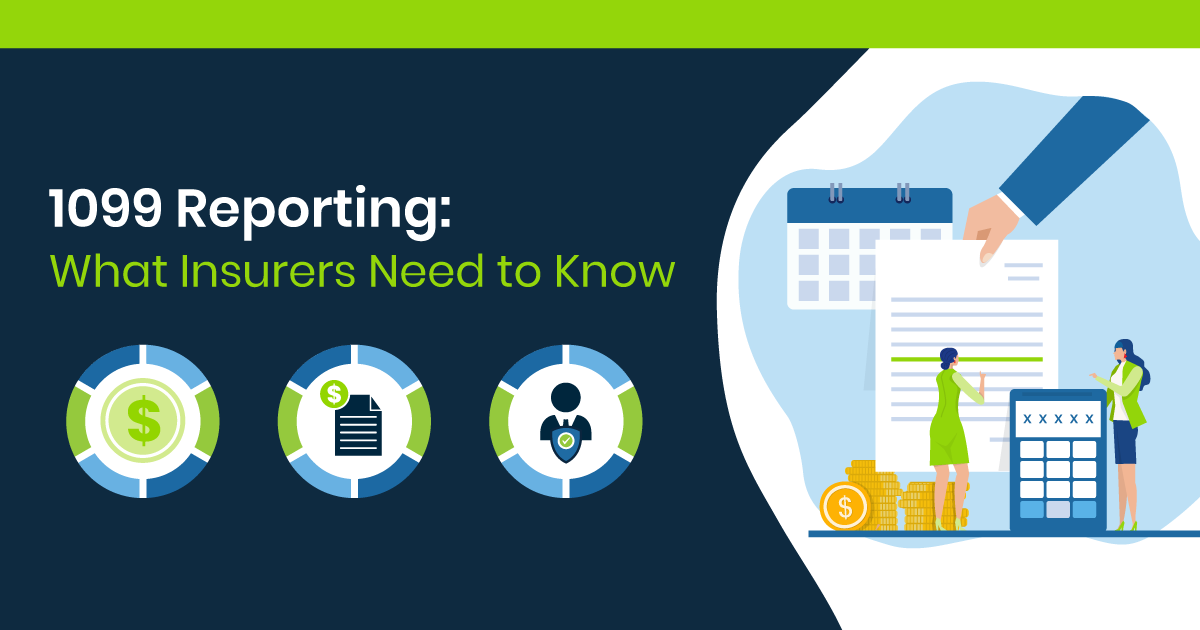
1099 Reporting: What Insurers Need to Know
The end of the year heralds the beginning of tax season. For insurers and other companies, this involves getting your 1099 paperwork ready. 1099 reporting requirements can be strict, and businesses that fail to comply can face expensive penalties. Here's what insurers need to know.
Your 1099 Responsibilities
The IRS1 sets a $600 threshold for 1099 reporting. If your business pays $600 or more to an independent contractor in a year, you must provide a 1099. Reporting is also required in various other situations. For example, payments from businesses to attorneys are reportable, and so are payments for medical and health care services, agent commissions and bonuses, and certain other payment types. Furthermore, when federal income tax is withheld under backup withholding rules, a 1099 is needed regardless of the payment amount.
When 1099 forms are required, they must be filed on time. According to the IRS Tax Calendars2 for 2022, businesses must file 1099 forms for nonemployee compensation paid in 2021 by Jan. 31, 2022. Additionally, 1099 forms for certain other types of payments must be sent to recipients by Jan. 31, 2022 and filed by Feb. 28, 2022.
How Carriers Can Stay Ahead of Filing Complexities
Filing a form may sound simple, but 1099 reporting involves many opportunities for human error. Here are just a handful of the questions that insurers must ask themselves when complying with 1099 filing requirements.
- Have you filed the correct type of 1099? There's more than one type. The IRS3 says that beginning with tax year 2020, business should use 1099-NEC (not 1099-MISC) to report nonemployee compensation.
- Are you meeting the correct deadlines? Although some 1099 forms don't need to be filed until Feb. 28, the Form 1099-NEC must be filed by Jan. 31.
- Have you missed anyone? Many types of payments require filing, and the $600 threshold does not always apply.
- Do you have all the correct information? Entering an incorrect business name or TIN/SSN can lead to unnecessary B Notices.
- Have you entered each piece of information in the correct box on the form? It's important to enter the information accurately.
- Is the form scannable? The IRS1 warns that businesses may face a penalty is they file forms that cannot be scanned.
- Are you meeting electronic filing requirements? According to the IRS4, the Taxpayer First Act of 2019 established electronic requirements for businesses that file at least 250 returns. Proposed regulations would decrease this threshold to 100 in 2022 and 10 in 2023.
- Have you remembered state 1099 reporting requirements? In addition to the federal requirements, states may have their own reporting rules. This can be especially complicated for businesses operating in multiple states or with independent contractors who work in another state.
- Are you following current regulations? State and federal requirements can change from year to year. If you're using outdated rules, you might not be compliant.
Getting Ready for Reporting Season
When insurers fail to meet 1099 reporting requirements, they can face financial penalties as well as reputational damage. To avoid issues, businesses must verify that they have all Taxpayer Identification Numbers (TINs), payment amounts and other pieces of data ahead of the filing deadline, and that all of this information is complete and correct. Businesses must also ensure that they have all resources needed to submit and file forms by the due date.
Stay Compliant with One Inc
At this point, you might be wishing for an easier way. Let's face it. The tax code isn't getting any simpler. Fortunately, One Inc 1099 services dramatically simplify 1099 filing and reporting with the following key advantages:
- Our platform provides a simple and flexible way to accurately categorize payments made to businesses throughout the year, enabling easier 1099 filing and reporting processes.
- Our payment APIs allow expenses to be categorized by recipient type (such as attorneys or medical providers) and by payment type (such as expense or indemnity).
- If there are specific payments that are not reportable, we provide a simple solution in our APIs for that as well.
- To prevent unnecessary B notices, we run TIN verifications throughout the year, so if a failure occurs you know well before submission deadlines and can make any necessary corrections well in advance.
The result is a far less arduous January for your team. To discuss your 1099 reporting and compliance challenges, please call (822) 209-1688 or email inquiries@oneinc.com.
Sources:1. https://www.irs.gov/businesses/small-businesses-self-employed/am-i-required-to-file-a-form-1099-or-other-information-return
2. https://www.irs.gov/pub/irs-pdf/p509.pdf
3. https://www.irs.gov/instructions/i1099msc
4. https://www.irs.gov/e-file-providers/filing-information-returns-electronically-fire
Tags: Business

Written by The One Inc Content Team
The One Inc Content Team strives to provide valuable insights about digital trends and payments innovation for the insurance community.
Want to read more articles like this?

